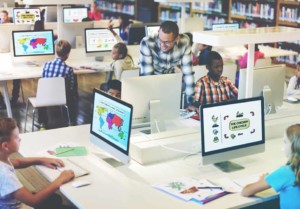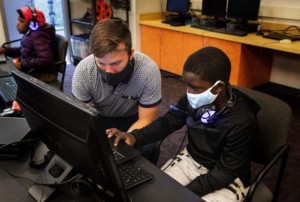Education 3.0: Helping All Children Reach their Potential

By: Charles M. Reigeluth
In the beginning was the one-room schoolhouse and the tutorial or apprenticeship model of education. Education 1.0 was ideal for the needs of the Agrarian Age. But, as any society evolves into the Industrial Age, its educational needs change dramatically, forcing a paradigm change to Education 2.0 – the factory model of schools – whose main feature is a focus on sorting students. The majority of jobs were manual labor, so there was no need to educate most students to high levels. They were prepared for the assembly lines by giving them boring, repetitive, remember-level tasks and a “hidden curriculum” that demanded compliance. All students were given the same amount of time to learn the material and norm-referenced testing or “grading on a curve” were used to force the slower learners to flunk out.
Now, as society evolves deeper into the information age (Toffler, 1980, 1990), educational needs are once again changing dramatically, making another paradigm change necessary. Knowledge work is replacing manual labor as the predominant form of work. Greater complexity in all aspects of our lives – from TV sets to retirement planning to participation in the democratic process – require much more education for a decent quality of life. In essence, we need to refocus education from sorting students to helping all students reach their potential. Since students learn at different rates, Education 2.0 made time a constant, forcing achievement to vary, with the effect of sorting out the to-be laborers from the managers and professionals. The alternative is to make achievement the constant, and allow each student the time she or he needs to learn. As described in the new book, Reinventing Schools: It’s Time to Break the Mold, this one change requires six massive changes throughout all aspects of an educational system:
Attainment-based system. For student progress to be based on learning rather than time, the paradigm of testing is changed from norm-referenced to criterion-referenced, and student records change from report cards that compare students with each other (through grades) to “records of attainments” in which each attainment is checked off when it is mastered. For more see, Considering Competency- Based Education.
Learner-centered instruction. Since different students are working on different attainments at any given time, learning is personalized with respect to both what is learned and how it is learned. Every student has a personal learning plan that allows them to cultivate their special talents as well as to master the 21st Century basics. Students work collaboratively on motivational, authentic projects that require learning the attainments specified in the personal learning plans. Instructional support in the form of personalized tutorials like those in the Khan Academy is provided during each project to accelerate learning, transfer skills beyond the single project, and ensure mastery.
Expanded curriculum. Basic skills are not ignored, but the accelerated learning offered by the attainment-based, learner-centered system allows additional focus on thinking skills, creativity, personal qualities, and other 21st Century skills. All aspects of child development are addressed, in partnership with the parents.
New roles. Teachers serve multiple roles as caring mentors, designers (and/or selectors) of engaging student work options, facilitators of student work, lifelong learners, and key decision-makers within their schools. Students are self-directed learners, teachers, and collaborative participants in learning. Parents are actively involved in both deciding what their child should learn and helping the child to learn it. Finally, technology and hands-on resources play a central rather than peripheral role to support creating personal learning plans, provide immersive project-based learning environments and personalized tutorials, provide formative and summative assessment of student learning, and keep track of each student’s attainments, as well as aid in collaboration, communication, and access to information.
A nurturing school culture. Small learning communities help develop student responsibility, caring, and leadership, and they improve quality of life for staff. Deep personal ties connect students, teachers, parents, and the larger community. Each student has a mentor for a developmental stage (about three or four years), so each teacher’s students are evenly distributed across a developmental stage. Intrinsic motivation is nurtured by learning through authentic, engaging projects that are relevant to students’ lives and interests. Teachers model lifelong learning by learning with, from, about, and for students. And the school collaborates with social service agencies to provide specialized services to families. For more on setting the school’s culture, see 10 Characteristics of Great School Cultures.
Organizational structures. Learning centers are used by students from all schools. Imagine a shopping mall that has learning centers rather than stores, ranging from national chains run by companies like Pearson, to a mom-and-pop shop run by, say, a retired electrician. This mall could be the hub of a wheel, with small schools located on the spokes. Teachers own their own schools, like partners in a law firm, but are not allowed to use any admissions criteria nor charge extra tuition, to ensure equal access by all students. Students choose their teacher (with a lottery if demand exceeds space), and high-demand teachers receive more money for their schools, allowing them to grow. Bureaucratic control of the schools is thereby replaced by a kind of market-driven system, making the schools more responsive to parent and community needs. The central office of a school district provides support services to the schools and learning centers – such as accounting, purchasing, cafeteria, maintenance, and transportation – for a fee, but the schools may use outside contractors for such services instead. The central office also has an agency to support all the schools and learning centers and to incubate new ones, which start up on a frequent basis. An independent consumer-aid type agency provides parents with objective information about each teacher, school, and learning center. Finally, many schools and learning centers operate as a learning cooperative where all members of the community may go to learn in exchange for donating skills and services. This and the elimination of bureaucracy do much to reduce the cost of education.
This vision of Education 3.0 is described in detail by Reigeluth and Karnopp in Reinventing Schools, which also describes three real school systems that have many of these features. The book also has a chapter on how to help school districts to transform to Education 3.0 and another on what governments can do to help.
Dr. Charles M. Reigeluth has a B.A. in Economics from Harvard University and a Ph.D. in Instructional Psychology from Brigham Young University. He taught high school science for three years, was a Professor in the Instructional Systems Technology Department at Indiana University for 25 years, and was chairman of the department for three years. His research focuses on paradigm change in public education, the design of high quality instruction, and the design of technology systems for the learner-centered paradigm of education. Helping schools to attain dramatic improvements is his passion. Follow him on Twitter at @CReigeluth
References
Khan Academy (see www.khanacademy.org)
Reigeluth, C. M., & Karnopp, J. R. (2013). Reinventing schools: It’s time to break the mold. Lanham, MD: Rowman & Littlefield (see www.reinventingschools.net).
Toffler, A. (1980). The third wave. New York: Bantam Books.
Toffler, A. (1990). Powershift. New York: Bantam.





0 Comments
Leave a Comment
Your email address will not be published. All fields are required.